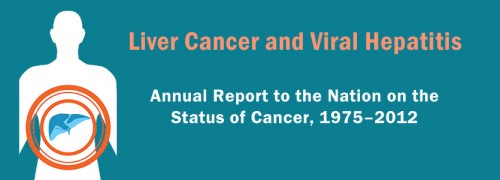Liver Cancer Death Rate Increasing Faster Than All Other Cancers; Implementation of Viral Hepatitis Action Plan Urgently Needed

On March 9th, the American Cancer Society, Centers for Disease Control and Prevention (CDC), National Cancer Institute, and the North American Association of Central Cancer Registries released their Annual Report to the Nation on the Status of CancerExit Disclaimer, revealing that the rate of new cases of liver cancer is rapidly increasing and the death rate from liver cancer is increasing faster than from all other cancers. Cancer remains the nation’s second leading cause of death. While we have made some great advances in viral hepatitis prevention and treatment, viral hepatitis is a leading cause of liver cancer in the United States. “The latest data show many cancer prevention programs are working and saving lives,” said CDC Director Tom Frieden, MD, MPH. “But the growing burden of liver cancer is troublesome. We need to do more work promoting hepatitis testing, treatment, and vaccination.”
This year’s report has a special feature that examines trends in liver cancer and highlights the hepatitis B virus (HBV) and the hepatitis C virus (HCV). The report findings remind us of the urgency of taking action on multiple fronts to achieve the goals of the national Viral Hepatitis Action Plan.
- Between 2003 and 2012, the rate of new cases of liver cancer increased by 3.4 percent per year among men and 2.4 percent per year among women.
- Between 2003 and 2012, the liver cancer-related death rate increased by 2.8 per year among men and 2.2 percent per year among women.
- Hepatitis C and liver cancer-associated death rates were highest among those born during 1945-1965; these also represent the majority of Americans with hepatitis C infection.
Fortunately, many opportunities exist to reverse these alarming trends including vaccination for hepatitis B, and testing and treatment for hepatitis B and C.

Hepatitis-Related Liver Cancer is PreventableThe American Association for the Study of Liver Diseases recommendsExit Disclaimer hepatitis C treatment for all patients with chronic hepatitis C and according to the cancer report, hepatitis C cures are associated with a 75% reduction in risk of liver cancer. The latest hepatitis C treatments have cure rates of 90-100%, but people can only begin treatment once they know their viral hepatitis status. Approximately 3.5 million people in the U.S. are living with hepatitis C, but most of them do not know they are infected.
As many as 2.2 million people in the U.S. are living with hepatitis B. According to the report, hepatitis B testing followed by hepatitis B therapy is associated with a 50%–80% reduction in the risk of liver cancer. Hepatitis screenings, vaccination, and other preventive services, are widely available and, often, without cost-sharing to people with health insurance. Learn more at https://healthfinder.gov/.
Known as the “silent epidemic,” viral hepatitis often has no symptoms that might prompt someone to seek a test until the disease has progressed. CDC’s 5-minute risk assessment is confidential and provides a personalized report that can be used to empower patients when they talk with their health care provider about viral hepatitis prevention and testing.
Liver Cancer Prevention Is Part of Reproductive Health
Newborns who become infected with hepatitis B at birth have a 90% chance of becoming chronically infected with hepatitis B, which can lead to liver cancer and premature death. All pregnant women should be screened for hepatitis B in their first trimester. For infants at risk, post-exposure prophylaxis is 85%-95% effective in preventing chronic hepatitis B.
Hepatitis B Testing Is Important for Persons born In Countries of Asia, Africa, and other Countries where HBV Infection is Common (> 2%)
Persons born in countries where hepatitis B is common (> 2% of the population) were typically infected at birth or during early childhood. Now as adults, the duration of their infection is placing them at high risk for HBV related liver disease including liver cancer.
Hepatitis C Testing Is Important for Persons Born Between 1945-1965
Approximately 75% of all hepatitis C cases are among baby boomers, persons born between 1945-1965. Hepatitis C was not discovered until 1989, so many baby boomers living with hepatitis C may have been exposed before it could be detected and diagnosed and may now be living with advanced-stage liver disease requiring immediate care. Both CDC and the U.S. Preventive Services Task ForceExit Disclaimer recommend that all “boomers” are tested for hepatitis C at least once, regardless of any risk factors. The screening is covered by Medicare in primary care settings.
The Way Forward
If we are to prevent new cases of liver cancer and save lives, we will need engagement from a variety of partners to implement the national Viral Hepatitis Action Plan , including you. Please join us in May for Hepatitis Awareness Month and May 19th for National Hepatitis Testing Day. These observances are designed to help bring awareness to viral hepatitis and liver cancer.
- Visit www.HIV.gov/hepatitis for the latest updates on our progress in implementing the national Viral Hepatitis Action Plan and watch for continued updates on this blog.
- Visit the CDC Cancer Prevention and Control website for information about some of the most common kinds of cancer in the United States.
- Get facts and download free educational tools from the CDC Viral Hepatitis website, your source for information on hepatitis B, hepatitis C, and other types of viral hepatitis.
Read more about liver cancer, viral hepatitis, and the Annual Report to the Nation on the Status of Cancer.